
United States gubernatorial elections were held in 1913, in four states. Massachusetts at this time held gubernatorial elections every year. It would abandon this practice in 1920. New Jersey at this time held gubernatorial elections every 3 years. It would abandon this practice in 1949. Virginia holds its gubernatorial elections in odd numbered years, every 4 years, following the United States presidential election year.

The 1955 United States gubernatorial elections were held in three states. Kentucky, Louisiana and Mississippi hold their gubernatorial elections in odd numbered years, every 4 years, preceding the United States presidential election year.

United States gubernatorial elections were held in 1951, in three states. Kentucky, Louisiana and Mississippi hold their gubernatorial elections in odd numbered years, every 4 years, preceding the United States presidential election year.
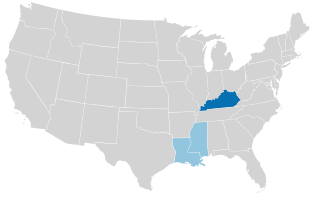
United States gubernatorial elections were held in 1947, in three states. Kentucky, Louisiana and Mississippi hold their gubernatorial elections in odd numbered years, every 4 years, preceding the United States presidential election year.
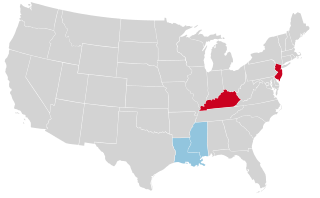
United States gubernatorial elections were held in 1943, in four states. Kentucky, Louisiana and Mississippi hold their gubernatorial elections in odd numbered years, every 4 years, preceding the United States presidential election year. New Jersey at this time held gubernatorial elections every 3 years, which it would abandon in 1949.

United States gubernatorial elections were held in 1939, in three states. Kentucky, Louisiana and Mississippi hold their gubernatorial elections in odd numbered years, every 4 years, preceding the United States presidential election year.

United States gubernatorial elections were held in 1935, in three states. Kentucky, Louisiana and Mississippi hold their gubernatorial elections in odd numbered years, every 4 years, preceding the United States presidential election year.

United States gubernatorial elections were held in 1931, in four states. Kentucky, Louisiana and Mississippi hold their gubernatorial elections in odd numbered years, every 4 years, preceding the United States presidential election year. New Jersey at this time held gubernatorial elections every 3 years. It would abandon this practice in 1949.
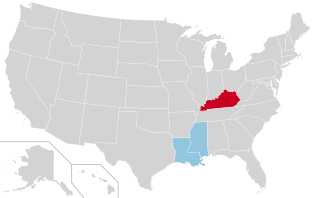
United States gubernatorial elections were held in 1927, in three states. Kentucky, Louisiana and Mississippi hold their gubernatorial elections in odd numbered years, every 4 years, preceding the United States presidential election year.
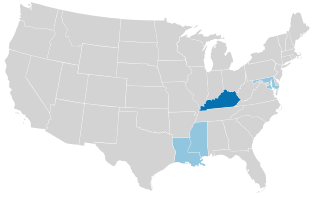
United States gubernatorial elections were held in 1923, in four states. Kentucky, Louisiana and Mississippi hold their gubernatorial elections in odd numbered years, every 4 years, preceding the United States presidential election year.
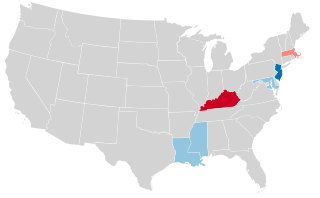
United States gubernatorial elections were held in 1919, in six states. Kentucky, Louisiana, Maryland and Mississippi held their gubernatorial elections in odd numbered years, every 4 years, preceding the United States presidential election year. New Jersey at this time held gubernatorial elections every 3 years. It would abandon this practice in 1949. This was the last time Massachusetts elected its governors to a single-year term. It switched to two-year terms from the 1920 election.

United States gubernatorial elections were held in 1915, in five states. Kentucky, Louisiana, Maryland and Mississippi held their gubernatorial elections in odd numbered years, every 4 years, preceding the United States presidential election year. Massachusetts elected its governors to a single-year term, switching to two-year-terms from the 1920 election.

United States gubernatorial elections were held in 1911, in eight states.
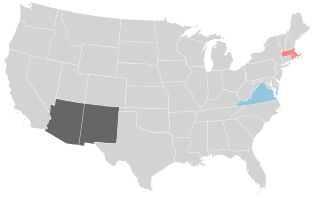
United States gubernatorial elections were held on November 2, 1909, in three states. Virginia holds its gubernatorial elections in odd numbered years, every 4 years, following the United States presidential election year. Massachusetts and Rhode Island at this time held gubernatorial elections every year. They would abandon this practice in 1920 and 1912, respectively.

United States gubernatorial elections were held in 1907, in eight states.

United States gubernatorial elections were held on November 7, 1905, in four states. Virginia holds its gubernatorial elections in odd numbered years, every 4 years, following the United States presidential election year. Massachusetts and Rhode Island at this time held gubernatorial elections every year. They would abandon in 1920 and 1912, respectively.

United States gubernatorial elections were held on November 5, 1901, in six states.

United States gubernatorial elections were held in 1899, in seven states.

United States gubernatorial elections were held in 1895, in nine states.
United States gubernatorial elections were held in 1885, in seven states.
















